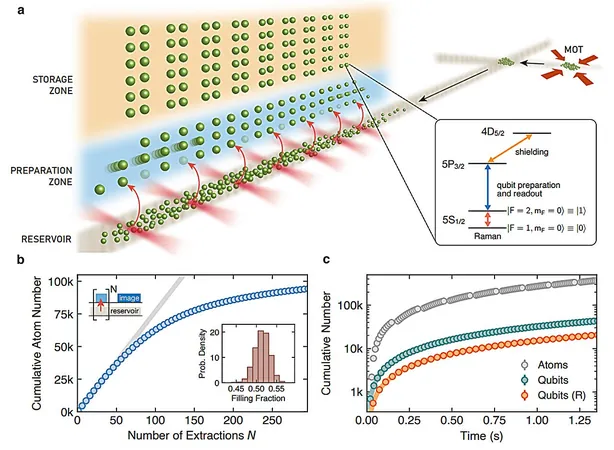
Breakthrough in Quantum Tech: 3,000-Qubit System Transforms Atom Reloading!
2025-09-22
Author: Wei Ling
Revolutionizing Quantum Computing with Continuous Operation
In a stunning leap forward, Harvard researchers have unveiled an advanced neutral atom array system boasting 3,000 qubits that can operate continuously for over two hours—an astounding improvement over the conventional lifetimes of just about 60 seconds. This breakthrough, reported in a recent Nature study, marks a significant stride in quantum computing.
The Challenge of Atom Loss—An Age-Old Dilemma
Traditional neutral atom systems utilize precision laser beams, or optical tweezers, to arrange and secure neutral atoms like rubidium in a vacuum. However, this method often leads to atom loss due to various operational issues, including entanglement errors and limited trap lifespans.
According to the study, "Atom losses necessitate pulsed operation, which hampers the quantum system’s performance, affecting circuit depth, atomic clock accuracy, and entanglement rates in quantum networking." This has been a persistent hurdle for researchers.
Enter the Dual Optical Lattice Conveyor Belt!
Breaking away from the limitations of pulsed operations, the Harvard team developed an innovative dual optical lattice conveyor belt system that continuously transports cold atom reservoirs to the science region. This allows for a staggering reloading rate of 300,000 atoms per second, with 30,000 qubits initialized every second to keep the 3,000-atom array dynamically refreshed.
Even with this rapid turnover, the system has maintained qubit coherence, including atoms in superposition states, showcasing its remarkable stability.
Preserving Quantum Information Like Never Before
One of the most impressive features of this new system is its ability to preserve information during atom replacement. As old atoms are swapped out, the information seamlessly transfers to the new array, ensuring data integrity remains intact.
Future Enhancements: The Sky's the Limit!
While these strides are commendable, the research team suggests that there’s more room for improvement. By harnessing AI and field-programmable gate arrays, they aim to enhance reloading rates by up to five times. Additionally, with advancements in optics and stabilization, larger arrays and prolonged operations could soon become a reality.
To further push the boundaries, researchers propose using higher-power trapping lasers and innovative optical designs like metasurfaces to vastly expand the array size and maximize the efficiency of continuous operations.
A Bright Future for Quantum Technologies!
This pioneering work heralds a new era for quantum networking and entanglement distribution, paving the way for ultra-reliable atomic clocks and high-stability quantum sensors. The far-reaching implications of this technology could transform numerous fields, pushing quantum computing and sensing into previously unreachable territories.





 Brasil (PT)
Brasil (PT)
 Canada (EN)
Canada (EN)
 Chile (ES)
Chile (ES)
 Česko (CS)
Česko (CS)
 대한민국 (KO)
대한민국 (KO)
 España (ES)
España (ES)
 France (FR)
France (FR)
 Hong Kong (EN)
Hong Kong (EN)
 Italia (IT)
Italia (IT)
 日本 (JA)
日本 (JA)
 Magyarország (HU)
Magyarország (HU)
 Norge (NO)
Norge (NO)
 Polska (PL)
Polska (PL)
 Schweiz (DE)
Schweiz (DE)
 Singapore (EN)
Singapore (EN)
 Sverige (SV)
Sverige (SV)
 Suomi (FI)
Suomi (FI)
 Türkiye (TR)
Türkiye (TR)
 الإمارات العربية المتحدة (AR)
الإمارات العربية المتحدة (AR)